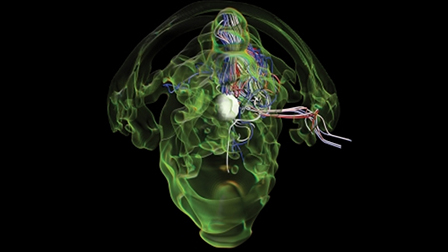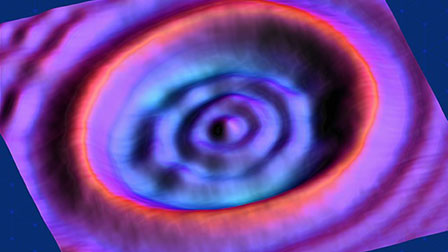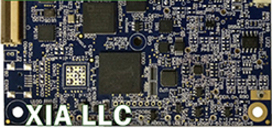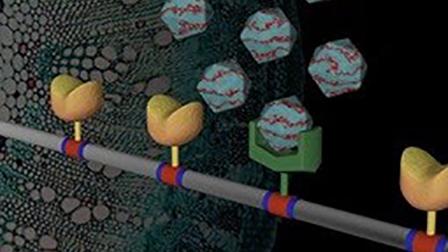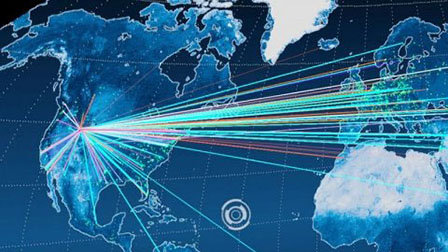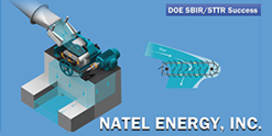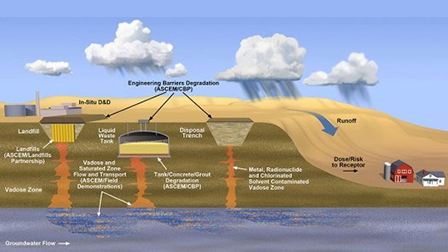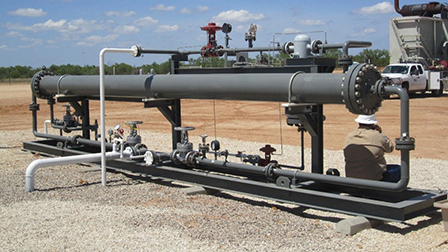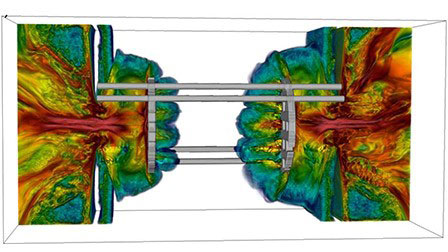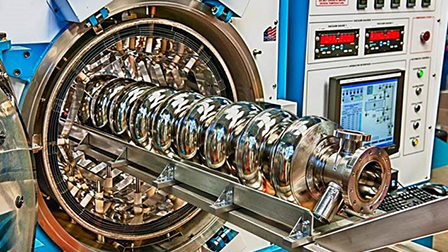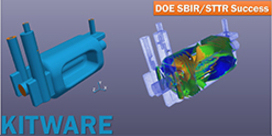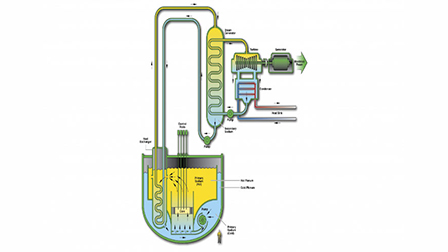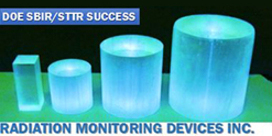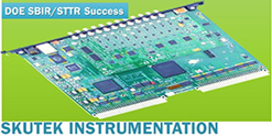Research Areas & Impact
DOE Program Offices
The SBIR/STTR Programs Office works collaboratively with 13 program offices throughout the DOE. Each DOE program office considers its high priority research needs and program mission, as well as the Department’s goals for the program in developing research topics. The specific research topics selected for the SBIR and STTR programs are developed by DOE technical program managers. DOE offers more than sixty technical topics and 250 subtopics, spanning research areas that support the DOE mission in Energy Production, Energy Use, Fundamental Energy Sciences, Environmental Management, and Defense Nuclear Nonproliferation.
Impact
DOE annually awards approximately 360 Phase I and 180 Phase II awards. Examples of recent awardees and their research projects are provided for each program office. Awardees are expected to transition their innovations to the marketplace through additional investment and partnering opportunities. Companies that have successfully addressed the commercialization challenge are provided below to provide insights and inspiration.
Office of Advanced Scientific Computing Research (ASCR)
Photo courtesy of Oak Ridge National Laboratory, David Pugmire
Scientists used Titan to model a supernova explosion from the collapsing core of a super-giant star.
The primary mission of the Advanced Scientific Computing Research (ASCR) program is to discover, develop, and deploy computational and networking capabilities to analyze, model, simulate, and predict complex phenomena important to the DOE.
A particular challenge of this program is fulfilling the science potential of emerging computing systems and other novel computing architectures, which will require numerous significant modifications to today's tools and techniques to deliver on the promise of exascale science.
ASCR funds research at public and private institutions and at DOE laboratories to foster and support fundamental research in applied mathematics, computer science, and high-performance networks. ASCR also operates high-performance computing (HPC) centers and related facilities, and maintains a high-speed network infrastructure at Lawrence Berkeley National Laboratory to support computational science research activities. ASCR supports research on applied computational sciences in the following areas:
- Applied and computational mathematics to develop the mathematical algorithms, tools, and libraries to model complex physical and biological systems;
- HPC science to develop scalable systems software and programming models, and to enable computational scientists to effectively utilize petascale computers to advance science in areas important to the DOE mission;
- Distributed network environment to develop integrated software tools and advanced network services to enable large-scale scientific collaboration and make effective use of distributed computing and science facilities in support of the DOE science mission; and
- Applied computational sciences partnership to achieve breakthroughs in scientific advances via computer simulation technologies that are impossible without interdisciplinary effort.
Recent Award Examples
|
Phase I |
Enhance the security of the High Performance Computing systems by providing an enhanced secure computing environment to assure the integrity, confidentiality, and availability of HPC systems. |
Intelligent Automation, Inc. |
Rockville |
MD |
|
|
Develop Photonic Memory Controller Module for High-Performance Computing and Big-Data |
Analog Photonics |
Hingham |
MA |
|
Phase II |
Develop a wrapper around existing high end DOE modeling software which will allow commercial entities to efficiently use this software. |
Subsurface Insights |
Hanover |
NH |
|
|
Develop methods and technology aimed at facilitating situation comprehension and radically reducing cognitive burden experienced by cyber analysts. |
Machine Understanding, LLC |
Potomac |
MD |
Phase III Success Stories
Office of Basic Energy Sciences (BES)
Image courtesy of Lawrence Berkeley National Laboratory
Trapped electrons that follow the rules of relativistic quantum mechanics were directly image.
The Office of Basic Energy Sciences (BES) supports fundamental research to understand, predict, and ultimately control matter and energy at the electronic, atomic, and molecular levels in order to provide the foundations for new energy technologies and to support DOE missions in energy, environment, and national security.
A key function of the BES program is to plan, construct, and operate premier scientific user facilities for the development of novel nanomaterials and for materials and chemical characterization through x-ray and neutron scattering; the former is accomplished through five Nanoscale Science Research Centers and the latter is accomplished through the world's largest suite of light source and neutron scattering facilities.
These national resources are available free of charge to all researchers based on the quality and importance of proposed nonproprietary experiments. A major objective of the BES program is to promote the transfer of the results of its basic research to advance and create technologies important to DOE missions in areas of energy efficiency, renewable energy resources, improved use of fossil fuels, and mitigation of the adverse impacts of energy production and use, and future nuclear energy sources.
Recent Award Examples
|
Phase I |
Narrow band laser source for efficient 3He polarization |
OptiGrate Corp |
Oviedo |
FL |
|
|
Development and Commercialization of a Novel Two-Color Hybrid Pixel X-Ray Detector |
Rayonix, LLC |
Evanston |
IL |
|
Phase II |
Develop a nationally accessible network of chemistry and materials data repositories to facilitate inter-organizational sharing, accelerating breakthroughs across industry, government, and academia. |
IllinoisRocstar LLC |
Champaign |
IL |
|
|
Convert organic waste into chemicals with widespread use in polymer and transportation industries. |
Visolis, Inc |
Berkeley |
CA |
Phase III Success Stories
Office Biological and Environmental Research (BER)
Image courtesy of the Environmental Molecular Sciences Laboratory
Certain enzymes (yellow & green) in fungal cellulosomes have great potential for breaking down the lignocellulose (blue) in plants into the building blocks for fuels.
The mission of the Biological and Environmental Research (BER) program is to support transformative science and scientific user facilities to achieve a predictive understanding of complex biological, earth, and environmental systems for energy and infrastructure security and resilience.
BER seeks to understand the biological, biogeochemical, and physical principles needed to fundamentally understand and be able to predict processes occurring at the molecular and genomics-controlled smallest scales to environmental and ecological processes at the scale of planet Earth. Starting with the genetic information encoded in organisms’ genomes, BER research seeks to discover the principles that guide the translation of the genetic code into the functional proteins and metabolic and regulatory networks underlying the systems biology of plants and microbes as they respond to and modify their environments.
Gaining a predictive understanding of biological processes will enable design and reengineering of microbes and plants for improved energy resilience and sustainability, including improved biofuels and bio-products, improved carbon storage capabilities, and controlled biological transformation of materials such as nutrients and contaminants in the environment.
BER research also advances the fundamental understanding of dynamic, physical, and biogeochemical processes required to systematically develop Earth System models that integrate across the atmosphere, land masses, oceans, sea ice, and subsurface required for predictive tools and approaches responsive to future energy and resource needs.
Recent Award Examples
|
Phase I |
Develop state-of-the-art lidar capabilities for cloud height and Atmospheric Boundary Layer measurement. |
Fibertek, Inc |
Herndon |
VA |
|
|
Develop an automated precipitation sensor to measure and classify precipitation in cold environments. The device has wide applicability for the weather, agricultural, insurance, military, and transportation safety sectors. |
Particle Flux Analytics, Inc. |
Salt Lake City |
UT |
|
Phase II |
Collaborate with InView and PNL Laboratory to develop an infrared imaging system to detect and quantify greenhouse gas emissions to better understand their life cycle and role in global earth system dynamics. |
Amethyst Research, Inc. |
Ardmore |
OK |
|
|
Develop an inexpensive way of sensing containments drinking water and wastewater from landfills. |
Analytical Instrument Systems, Inc. |
Ringoes |
NJ |
Phase III Success Stories
Coming Soon!
Office of Cybersecurity, Energy Security, and Emergency Response (CESER)
The primary mission of CESER is to lead the Department of Energy’s emergency preparedness and coordinate responses to disruptions to the energy sector, including physical and cyber-attacks, natural disasters, and man-made events.
CESER addresses the emerging threats of tomorrow while protecting the reliable flow of energy to Americans today by improving energy infrastructure security and supporting ’DOE's national security mission. CESER’s focus is preparedness and response activities to natural and man-made threats, ensuring a stronger, more prosperous, and secure future for the Nation.
CESER is tactically and strategically addressing the increased frequency and sophistication of cyber threats. CESER is furthering the Department’s long history of investing in research and development (R&D) by industry and the National Labs of the next generation of advanced technologies. CESER leverages the National Labs to test components and configurations based on feedback from industry. Continuous monitoring tools and capabilities for information systems and control networks and identifying best practices are also vital and supported by efforts such as CESER’s Cybersecurity Risk Information Sharing Program.
Being prepared and ready to respond quickly and effectively to all hazards is crucial. In partnership with companies across the energy sector through organizations such as the Electricity Subsector Coordinating Council and the Oil and Natural Gas Subsector Coordinating Council, CESER plays a vital role in coordinating Federal and state government strategies with industry. Furthermore, CESER along with energy sector partners, prepare for various types of emergencies through exercises such as Clear Path and GridEx. These exercises help DOE, industry, and government partners test and improve plans, as well as provide insights for future R&D needs. When an incident occurs, CESER facilitates coordination across the government and with the energy sector to enhance response and recovery efforts while coordinating Federal capabilities to mitigate the impact of energy disruptions.
Recent Award Examples
Coming Soon!
Phase III Success Stories
Office of Defense Nuclear Nonproliferation R&D (DNN)
This commercial GeGI Germanium Gamma-ray Imaging Detector developed by PHDS Corporation uses compact electronics.
The Office of Defense Nuclear Nonproliferation Research and Development (DNN R&D) reduces the threat to national security by advancing U.S. capabilities to detect and monitor foreign nuclear fuel cycle and weapons development activities, special nuclear material (SNM) movement or diversion, and nuclear explosions. These same capabilities support nuclear arms control treaty monitoring and verification, operational interdiction, and other nuclear security missions across DOE/NNSA and the U.S. Government.
To address these mission needs, identify gaps, and prioritize research, DNN R&D coordinates with partner DOE and NNSA national laboratories, sites, and plants, in addition to stakeholders and end-users, in its development of long-term strategic roadmaps. Additionally, DNN R&D partners with academia and private industry. Through these multiple partnerships and collaborations, DNN R&D advances the technical base for national and homeland security agencies to meet their nonproliferation, counterproliferation, incident response, and counterterrorism responsibilities.
Recent Award Examples
|
Phase I |
Develop robust particle accelerator to be used as a medical accelerator or as a replacement for radioactive isotopes. |
Euclid Techlabs |
Solon |
OH |
|
|
Develop a simplified, efficient, highly-automated medical linear accelerator system to address the problem of limited access to modern radiotherapy equipment in low-income and middle-income countries. |
RadiaBeam Systems |
Santa Monica |
CA |
|
Phase II |
Develop an instrument for Analysis of Nuclear Materials with Heterogeneous Isotopic Composition |
Applied Spectra, Inc. |
Fremont |
CA |
|
|
Develop a High Performance Scintillator for Gamma Ray Spectroscopy |
CapeSym, Inc. |
Natick |
MA |
Phase III Success Stories
Electricity
The Office of Electricity Delivery and Energy Reliability (OE) provides national leadership to ensure that the Nation’s energy delivery system is secure, resilient, and reliable. OE works to develop new technologies to enhance the infrastructure that brings electricity into our homes, offices, and factories and to improve the federal and state electricity policies and programs that shape electricity system planning and market operations.
OE also works to bolster the resiliency of the electric grid and assists with restoration when major energy supply interruptions occur. As the lead for the DOE efforts on grid modernization, OE works closely with diverse stakeholders to ensure that clean energy technologies can be integrated in a safe, reliable, and cost-effective manner. OE leverages effective partnerships, solid research, and best practices to address diverse interests in achieving economic, societal, and environmental objectives.
Further information regarding the challenges and needs associated with the Nation’s energy infrastructure can be found in the 2015 releases of the Department’s Quadrennial Energy Review and Quadrennial Technology Review.
Recent Award Examples
|
Phase I |
Rapid Assessment of Distribution Line Damage via Autonomous UAV |
Brains4Drones LLC |
Plano |
TX |
|
|
Automatic Outage Detection and Localization by Analysis of Interrogation Signals |
Escondido |
Escondido |
CA |
|
Phase II |
Develop a reliable, efficient, and secure method of managing the electrical grid. The approach developed here uses an Agoric (market-based) control method coupled with a fractal grid architecture (multiple similar control levels) to enable innovative computational intelligence technology to effectively control the electrical grid from the edge. |
Introspective Systems LLC |
Portland |
ME |
|
|
Enable domain experts to customize modern technology to support legacy use cases and evolve to cloud based approaches to realize more efficient operation and management of the electrical grid. |
Machfu Inc. |
Germantown |
MD |
Phase III Success Stories
Coming Soon!
Office of Energy Efficiency and Renewable Energy (EERE)
DOE's Office of Energy Efficiency and Renewable Energy (EERE) supports early-stage research and development of energy efficiency and renewable energy technologies that make energy more affordable and strengthen the reliability, resilience, and security of the U.S. electric grid. EERE’s Technology Office activities are conducted in partnership with the private sector (including small businesses), DOE national laboratories, universities, and state and local governments.
EERE also works with stakeholders to develop programs and policies to facilitate the deployment of advanced clean energy technologies and practices.
Recent Award Examples
|
Phase I |
Geothermal HVAC - PCM Seasonal Energy Storage |
Melink Corporation |
Cincinnati |
OH |
|
|
Biologically Inspired Ammonia Production with Immobilized Nitrogenase |
Fulcrum BioScience LLC |
West Jordan |
UT |
|
Phase II |
Install a fully functional, independent, integrated, scalable and highly efficient, 100-gallon/day potable water system providing the highest purity, sanitized (insitu disinfection), with minimal environmental footprint and optional hot water delivery for isolated communities such as islands and rural areas. |
Xergy Incorporated |
Seaford |
DE |
|
|
Develop an economical technology to convert rancid, no-value, environmentally adverse brown grease into a high quality, valued biodiesel fuel. |
CF Technologies, Inc. |
Hyde Park |
MA |
Phase III Success Stories
Office of Environmental Management (EM)
With the end of the Cold War, DOE is focusing on understanding and eliminating the enormous environmental problems created by the Department's historical mission of nuclear weapons production. The DOE's Office of Environmental Management (EM) seeks to eliminate these threats to human health and the environment, as well as to prevent pollution from on-going activities.The goals for waste management and environmental remediation include:
- Meeting regulatory compliance agreements,
- Reducing the cost and risk associated with waste treatment and disposal, and
- Expediently deploying technologies to accomplish these activities.
While radioactive contaminants are the prime concern, hazardous metals and organics are also important. DOE has approximately 91 million gallons of liquid waste stored in underground tanks and approximately 4,000 cubic meters of solid waste derived from the liquids stored in bins.
DOE also manages some of the largest groundwater and soil contamination problems and subsequent cleanup in the world. This includes the remediation of 40 million cubic meters of contaminated soil and debris contaminated with radionuclides, metals, and organics.
The Office of Groundwater and Soil Remediation focuses on four areas of applied research including the Attenuation-Based Remedies for the Subsurface Applied Field Research Initiative (Savannah River Site), the Deep Vadose Zone Applied Field Research Initiative (Hanford Site), the Remediation of Mercury and Industrial Contaminants Applied Field Research Initiative (Oak Ridge Site), and Advanced Simulation Capability for Environmental Management.
Recent Award Examples
Coming Soon!
Phase III Success Stories
Coming Soon!
Office of Fossil Energy (FE)
Membrane fuel gas conditioning unit developed by Membrane Technology and Research, Inc. used to treat natural gas.
The DOE Office of Fossil Energy (FE) plays a key role in helping the U. S. meet its continually growing need for secure, reasonably priced and environmentally sound fossil energy supplies. FE’s primary mission is to ensure the nation can continue to rely on traditional resources for clean, secure and affordable energy while enhancing environmental protection. Fossil fuels are projected to remain the mainstay of energy consumption, currently 80% of U.S. energy consumption, well into the next century. Consequently, the availability of these fuels, and their ability to provide clean, affordable energy is essential for global prosperity and security. As the nation strives to reduce its reliance on imported energy sources, FE supports R&D to promote the secure, efficient and environmentally sound production and use of America’s abundant fossil fuels in both existing and new infrastructure.
To this end FE concentrates its Phase I SBIR/STTR efforts on two areas that significantly support and enable development of several fossil energy technologies:
- Sensors & Controls, and
- Advanced Manufacturing & Materials.
Recent Award Examples
|
Phase I |
Enhancing Energy Systems Cybersecurity using Blockchains |
Real-Time Innovations, Inc. |
Sunnyvale |
CA |
|
|
Three Step Additive Manufacturing of Complete Solid Oxide Fuel Cells |
HAMR Industries LLC |
State College |
PA |
|
Phase II |
Develop technology that uses biologically produced minerals to seal problematic leaking wells. |
Tech4Imaging LLC |
Butte |
MT |
|
|
Develop high temperature, oxidation, corrosion creep and erosion resistant super-alloy composite powders for additive manufacturing (AM) and components fabricated by AM for future advanced turbine system and can be used for retrofitting existing fossil-fired power plant equipment |
Montana Emergent Technologies |
Cypress |
TX |
Phase III Success Stories
Office of Fusion Energy Sciences (FES)
3D FLASH simulation of the experimental platform, performed on the Mira supercomputer. Shown are renderings of the simulated magnetic fields before the flows collide.
The mission of the Fusion Energy Sciences (FES) program is to expand the fundamental understanding of matter at very high temperatures and densities and to build the scientific foundation needed to develop a fusion energy source. This is accomplished through the study of plasma, the fourth state of matter, and how it interacts with its surroundings.
FES has four strategic goals"
- Advance the fundamental science of magnetically confined plasmas to develop the predictive capability needed for a sustainable fusion energy source;
- Support the development of the scientific understanding required to design and deploy the materials needed to support a burning plasma environment;
- Pursue scientific opportunities and grand challenges in high energy density plasma science to better understand our universe, and to enhance national security and economic competitiveness, and;
- Increase the fundamental understanding of basic plasma science, including both burning plasma and low temperature plasma science and engineering, to enhance economic competiveness and to create opportunities for a broader range of science-based applications.
The next frontier for fusion research is the study of the burning plasma state, in which the fusion process itself provides the dominant heat source for sustaining the plasma temperature (i.e., self-heating). Production of strongly self-heated fusion plasmas will allow the discovery and study of new scientific phenomena relevant to fusion energy, including the properties of materials in the presence of high heat and particle fluxes and neutron irradiation.
To achieve its research goals, FES invests in flexible U.S. experimental facilities of various scales, international partnerships leveraging U.S. expertise, large-scale numerical simulations based on experimentally validated theoretical models, development of advanced fusion-relevant materials, and invention of new measurement techniques. FES also supports discovery plasma science, including research in laboratory plasma astrophysics, low-temperature plasmas, small-scale magnetized plasma experimental platforms, and high-energy-density laboratory plasmas.
Recent Award Examples
|
Phase I |
A Compact, High Intensity Laser Source for Inverse Compton Scattering |
Voss Scientific, LLC |
Albuquerque |
NM |
|
|
Plasma-Assisted Low-Temperature Combustion and Ignition |
Advanced Cooling Technologies, Inc. |
Lancaster |
PA |
|
Phase II |
Develop a fast, high voltage switch module that utilizes the latest and most efficient solid-state devices for the fusion energy R&D. |
Eagle Harbor Technologies, Inc. |
Seattle |
WA |
|
|
Develop a high quality supply of crystals and bent optics to benefit fusion energy research. |
Inrad Optics Inc. |
Northvale |
NJ |
Phase III Success Stories
Coming Soon!
Office of High Energy Physics (HEP)
Image courtesy of Fermilab
Advances in superconducting radiofrequency accelerator technology may lead to significant cost reductions in operating mid-term future machines.
The goal of the DOE Office of High Energy Physics (HEP) is to provide mankind with new insights into the fundamental nature of energy and matter and the forces that control them.
HEP is a major component of the Department's fundamental research mission. Such fundamental research provides the necessary foundation that enables the nation to advance its scientific knowledge and technological capabilities, to advance its industrial competitiveness, and to discover new and innovative approaches to its energy future.
The HEP program supports research in three discovery frontiers: the energy frontier, the intensity frontier, and the cosmic frontier. Experimental research in HEP is largely performed by university and national laboratory scientists, often using particle accelerators located at major laboratories in the U.S. and abroad. Under the HEP program, the DOE operates the:
- Fermi National Accelerator Laboratory (Fermilab. Fermilab includes the Main Injector (which formerly fed the now dormant Tevatron ring), which is used to create high-energy particle beams for physics experiments, including the world’s most intense neutrino beam.
- The SLAC National Accelerator Laboratory and the Lawrence Berkeley National Laboratory are involved in the design of state-of-the-art accelerators and related facilities for use in high-energy physics, condensed matter research, and related fields. SLAC facilities include the three kilometer long Stanford Linear Accelerator capable of generating high energy, high intensity electron and positron beams.
- Brookhaven National Laboratory operates the Accelerator Test Facility, which supports accelerator science and technology demonstrations with electron and laser beams. While much progress has been made during the past five decades in our understanding of particle physics, future progress depends on a great degree of availability of new state-of-the-art technology for accelerators, colliders, and detectors operating at the high energy and/or high intensity frontiers.
As stewards of accelerator technology for the nation, HEP also supports development of new concepts and capabilities that further scientific and commercial needs beyond the discovery science mission. The DOE SBIR/STTR programs provide a focused opportunity and mechanism for small businesses to contribute new ideas and new technologies to the pool of knowledge and technical capabilities required for continued progress in HEP research, and to turn these novel ideas and technologies into new business ventures.
Recent Award Examples
|
Phase I |
Novel Ultra-High Power Microwave Isolators |
Tibaray |
Stanford |
CA |
|
|
Integrated 2.0 µm Femtosecond Laser Amplifier for Advanced Accelerator Applications |
Gener8 Inc. |
Sunnyvale |
CA |
|
Phase II |
Advance the production of high density interconnect detectors that can survive the environments of the modern and future experiments. |
Advanced Research Corporation |
White Bear Lake |
MN |
|
|
Develop a radiation-hard power converter for the planned upgrades of the Large Hadron Collider |
Alphacore Inc. |
Tempe |
AZ |
Phase III Success Stories
Office of Nuclear Energy (NE)
Idaho National Laboratory
SFRs are designed to manage high-level waste and, in particular, plutonium and other actinides.
The primary mission of the Office of Nuclear Energy (NE) is to advance nuclear power as a resource capable of meeting the Nation's energy, environmental, and national security needs by resolving technical, cost, safety, proliferation resistance, and security barriers through research, development, and demonstration as appropriate. NE’s programs are guided by three priority focus areas:
- Maintaining the current nuclear reactor fleet;
- Encouraging growth for a new advanced reactor pipeline (both near- and longer-term), including through the employment of key private-public partnerships; and,
- Redeveloping America's nuclear fuel cycle, infrastructure, and supply chain. Nuclear energy is a key element of United States (U.S.) energy independence, energy dominance, electricity grid resiliency, national security, and clean baseload power.
America's nuclear energy sector provides over 60 percent of the nation's annual clean electricity production, generates nearly 20 percent of U.S. electricity from a fleet of 99 operating units in 30 states, supports 500,000 jobs, and contributes $60 billion per year to the U.S. Gross Domestic Product.
The U.S. nuclear energy sector also plays key national security and global strategic roles for the U.S., including nuclear nonproliferation. The NE SBIR/STTR work scope also supports the DOE Gateway for Accelerated Innovation in Nuclear (GAIN) initiative (see https://gain.inl.gov), which provides the nuclear energy community with access to the technical, regulatory, and financial support necessary to move new or advanced nuclear reactor designs toward commercialization while ensuring the continued safe, reliable, and economic operation of the existing nuclear fleet.
Recent Award Examples
|
Phase I |
Deep Burn Fuels for Advanced Small Modular Reactors |
Ultramet |
Pacoima |
CA |
|
|
Remote Repair of Sealed Containers or Dry Storage Casks Containing Used Nuclear Fuel |
Innovative Technologies International, Inc. |
Lynchburg |
VA |
|
Phase II |
Developing and advanced design for Scalable S-CO2 Turbomachinery Systems |
Mohawk Innovative Technology, Inc. |
Albany |
NY |
|
|
Developing a web-based advanced simulation management tool to support open- and government-sourced applications to enable identification of modeling codes, remote execution, and cloud visualization, and workflow management/provenance. |
RNET Technologies, Inc. |
Dayton |
OH |
Phase III Success Stories
Office of Nuclear Physics (NP)
Nuclear physics (NP) research seeks to understand the structure and interactions of atomic nuclei and the fundamental forces and particles of nature as manifested in nuclear matter.
Nuclear processes are responsible for the nature and abundance of all matter, which in turn determines the essential physical characteristics of the universe. The primary mission of the NP Program is to develop and support the scientists, techniques, and facilities that are needed for basic nuclear physics research and isotope development and production. Attendant upon this core mission are responsibilities to enlarge and diversify the Nation's pool of technically trained talent and to facilitate transfer of technology and knowledge to support the Nation's economic base.Nuclear physics research is carried out at national laboratories and accelerator facilities, and at universities. The Continuous Electron Beam Accelerator Facility at the Thomas Jefferson National Accelerator Facility allows detailed studies of how quarks and gluons bind together to make protons and neutrons. The Relativistic Heavy Ion Collider (RHIC) at Brookhaven National Laboratory (BNL) is forming new states of matter, which have not existed since the first moments after the birth of the Universe; a beam luminosity upgrade is currently underway.
The NP program also supports research and facility operations directed toward understanding the properties of nuclei at their limits of stability, and of the fundamental properties of nucleons and neutrinos.
Of interest is R&D related to future experiments in fundamental symmetries such as neutrino-less double-beta decay experiments and measurement of the electric dipole moment of the neutron, where extremely low background and low count rate particle detections are essential.
Another area of R&D is rare isotope beam capabilities, which could lead to a set of accelerator technologies and instrumentation developments targeted to explore the limits of nuclear existence. By producing and studying highly unstable nuclei that are now formed only in stars, scientists could better understand stellar evolution and the origin of the elements. Our ability to continue making a scientific impact on the general community relies heavily on the availability of cutting edge technology and advances in detector instrumentation, electronics, software, accelerator design, and isotope production.
Recent Award Examples
|
Phase I |
Develop a diagnostic tool to non- invasively measure electron spin in particle accelerators. |
Electrodynamic |
Albuquerque |
NM |
|
|
Provide the capability to further enhance experiments using rare isotopes. |
Reactive Innovations, LLC |
Westford |
MA |
|
Phase II |
This project will exploit recent advances in carbon nanomaterials and low-cost manufacturing techniques to generate carbon foils that can be used current and future accelerators. |
Applied Nanotech, Inc. |
Austin |
TX |
|
|
This project will advance digital signal processing electronics to support development of technologies essential to experiments in basic research. |
SkuTek Instrumentation |
West Henrietta |
NY |

